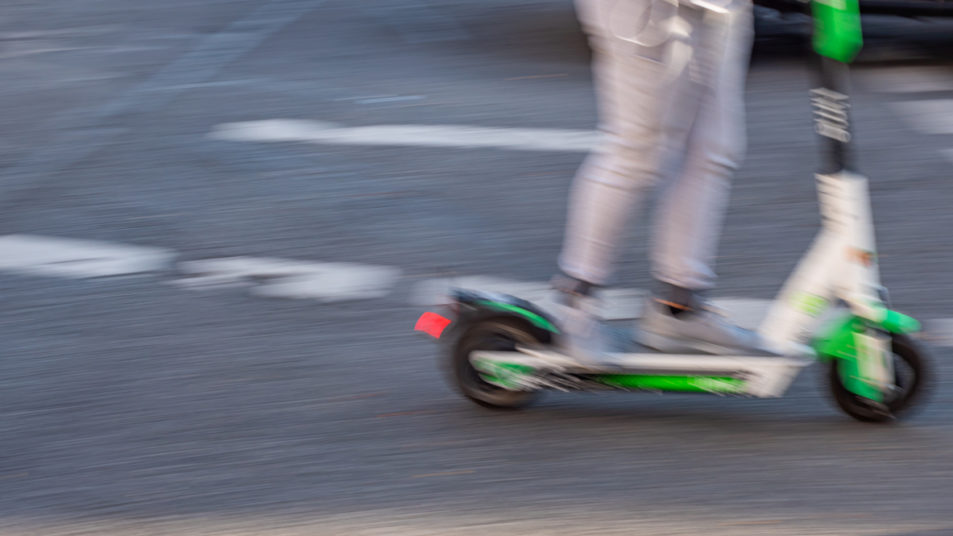E-Scooter Companies Lobby to Modify New California Bill Before Senate Vote
In the wake of a recent study on e-scooter injuries conducted by the American Medical Association, California is taking action.
The study looked at the types of injuries sustained by e-scooter riders as presenting to emergency rooms in L.A. County. It also looked at the use or lack of helmets used by riders.
E-scooters such as those provided by companies like Lime and Bird made their way to Santa Monica, California in 2017. These scooters are popular. They are fun, easy to use, cost little to rent, and are a ready tool for micro-mobility. And their popularity is growing.
E-scooters are placed around a city or on college campuses and can be located and unlocked through an app on a smartphone. Once the rider pays the fee and agrees to the company’s user agreement, they are free to go.
The scooters can go up to 16 mph. The rider stands on the scooter which has handlebars approximately waist high. When the rider is through. The rider ends the use on the app and leaves the scooter at their destination to be located later either by another rider or by a company employee at the end of the day.
The study looked at injuries arising out of scooter use that were severe enough to trigger an emergency room visit over the course of one year. The study recorded 249 scooter injuries over that time. Most of the injuries occurred as a result of a fall (80.2%), collision with an object (11.0%), or being hit by a moving vehicle or object (8.8%). Of the 249 injuries, only 10 riders wore helmets.
The most common injuries were fractures (31.7%), head injuries (40.2%), and soft-tissue injuries (27.7%). Many of the fractures required surgery and hardware to secure the bones. Head injuries include serious head traumas. Several of the injured riders were under the age of 18.
Original California Bill
As a result of rising injuries, California legislators drafted AB 1286 in 2018. The bill as originally drafted was a two-prong attempt to protect the public. The first prong was a requirement that all e-scooter companies obtain permits from the cities or counties in which they operate. Along with the permit requirement, the bill required that e-scooter companies purchase general liability insurance which would provide no less than $1,000,000 of coverage per occurrence.
The second prong of the bill would have required e-scooter companies to change their user agreements. These companies currently have user agreements that contain liability waivers and cap damages at $100 In some instances. The bill, as originally drafted in 2019, contained language that would prohibit any language in the user agreement which would waive, release, or in any way limit a rider’s legal rights, remedies, or forum under the agreement. This prong of the legislation has come under heavy attack by the e-scooter industry.
E-Scooter Objections
E-scooter companies have depended on these waivers and damages caps to manage their exposure to liability. Because California generally upholds these waivers, it has been difficult for injured parties to sue these companies. Cases have been brought alleging product defects, but the waivers make negligence difficult to prove.
Forbidding these waivers, releases and caps, would open these e-scooter companies to a much greater risk of liability exposure. The industry as a whole made it clear to the California legislature that it felt the imposition of the removal of waivers and damages caps was an unfair burden upon them and would make it difficult if not impossible for them to operate their businesses. They argued further that waivers and damages caps are standard contractual clauses designed to protect companies from liability for accidents caused through no fault of their own. They requested that this section of the bill be removed.
The California legislature, afraid that the e-scooter industry would pull out of California If the bill kept the restriction, has removed it from the final bill’s language.
In its version of August 25, 2020, the bill requires that e-scooter companies obtain permits, obtain sufficient liability coverage, and requires local jurisdictions to adopt operation, parking, and maintenance rules. The changes must be put in place by 2021. The bill has now been passed to the governor for signature.
Implications for Injured Parties
The original language restricting the rights of e-scooter companies to use waivers, releases and restrictions on damages would have made it much easier for injured parties to sue to get compensation for their injuries. The legislation as it stands now will continue to make it difficult for plaintiffs. This is troubling particularly in light of the seriousness of many of the injuries sustained by riders.
It is also not clear whether these contractual limitations will curtail a rider’s ability to collect compensation from insurance companies which cover e-scooters. If so, the legislation would seem to have been a pointless exercise.
These cases will likely continue to be difficult, but not impossible to litigate. Cases based on product defects and negligent maintenance continue to be brought against e-scooter companies. When these injuries occur, it is important to consult with a personal injury attorney.

Leave a Reply